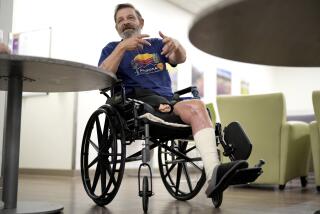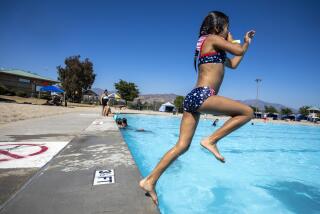Playgrounds Are Not All Fun And Games
- Share via
WASHINGTON — A playground is not a baby-sitter, and parents who think otherwise may wind up taking their children to an emergency room.
Playground injuries sent more than 267,000 children under 15 to a hospital in 1992, according to the U.S. Consumer Product Safety Commission.
“As long as you have children who are active in playing, injuries are bound to occur,” said pediatric orthopedic surgeon Richard J. Haynes of Phoenix.
Parents can’t assume that older children, who should know better, face less risk than preschoolers. Two-thirds of the injuries were to children over five, Dr. Haynes said.
It’s not that sending a child to a playground is like telling him to play in traffic.
“Parents should try to have their kids in an environment where risks are minimized, but some risks are worth taking,” said Dr. Peter B. Slabaugh of Oakland, Calif.
“Playgrounds offer a safe environment where children have fun (and) learn social and physical skills,” Dr. Haynes said.
Haynes, Slabaugh and other doctors in the American Academy of Orthopaedic Surgeons point out, however, that equipment should be kept safe and that parents should be vigilant.
Children fall from playground equipment, and injuries are worse if they land on a hard surface, such as asphalt. Falls to a surface account for 58% of injuries in the CPSC tally, Dr. Haynes said.
The best surface is energy-absorbent, such as a pile of double-shredded mulch, the doctors say. Hard-packed dirt or grass does not qualify as energy-absorbent, Dr. Slabaugh said.
Swings were the most risky, accounting for 37% of all injuries, Monkey bars followed with 29%, and slides with 21%, Dr. Haynes said.
A properly designed slide should be no more than about 12-15 inches off the ground where the child slides off, to prevent a hard landing, Dr. Slabaugh said.
Some playground equipment is not recommended for younger children, the CPSC says in its Handbook for Public Playground Safety. For instance, children younger than four should not try to hang from overhead horizontal ladders, it says. Preschoolers should not try the vertical sliding poles, or the merry-go-round, it says.
Parents also need to inspect equipment for loose bolts and screws, the doctors recommend. The CPSC says the connectors should be corrosion-resistant.
Parents also should check the heat of bare metal in sunlight before a child gets burned on it.
Also, they say, the playground should be laid out in a way that reduces the risk of children banging into one another.
“You don’t want to have big kids playing really fast-moving games near to little ones,” said Dr. Tony Rankin of Washington.
Active areas such as swings should be separated from quiet areas like sandboxes. Preschoolers’ areas should be separated from play areas for more active older children. And popular equipment in general should be spaced widely apart, they say.
It also warns that some openings in playground equipment, such as open risers on stairs, can trap a child’s head.
Although most injuries are only cuts and scrapes, a significant number of children break bones, Dr. Slabaugh said. These generally occur in the wrist or elbow, as a kid sticks out his arm to break a fall, he said.
A broken bone heals in a child in about half the time it takes for an adult, Dr. Rankin said.
“The majority are relatively innocuous fractures that are a part of growing up,” Dr. Haynes said.
The American Academy of Orthopaedic Surgeons’ brochure, Play It Safe, is available free by calling (800) 824-BONES (824-2663).
More to Read
Inside the business of entertainment
The Wide Shot brings you news, analysis and insights on everything from streaming wars to production — and what it all means for the future.
You may occasionally receive promotional content from the Los Angeles Times.










